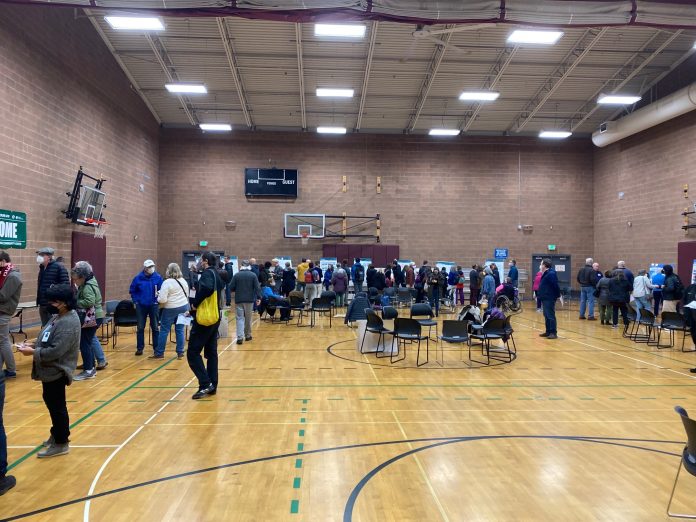An accidental game of musical chairs at a packed community meeting on the Comprehensive Plan provided a microcosm for Seattle’s housing crisis.
When you come to a two-hour community event, you expect to have a seat. And when you move to a place like Seattle, you expect there’s a home for everyone. Earlier this month, community members gathered in Meadowbrook Community Center to discuss how to make sure the next generation of Seattle has enough homes. People who were excited to shape the city’s future soon found out there weren’t enough chairs at the meeting.
As the open house portion of the event turned to breakout sessions, with small clusters of chairs shaped into circles, planners organizing the event announced they wouldn’t have enough chairs for everyone. They followed up stating they had met before the event and planned to bring enough chairs for an expected attendance, but obviously miscalculated. Quite the irony for the evening, considering this meeting was about how the last Comprehensive Plan fell short on housing supply.
Well, that plan failed, now what?
I watched the game of musical chairs unfold, seeing some take open seats and others lose out. People who got there earlier got to pick from a plethora of available seats, and the choice of whether to sit next to their friends and family. As chairs one by one filled up, and vacancy figures plummeted, people settled for any chair whatsoever, separating across the room from family or friends. Someone even sprinted to an empty seat before it was taken.
The music stopped. The chairs ran out. People who didn’t get one stood around confused.
To avoid deterring the chairless folks from leaving, facilitators acknowledged them and encouraged people without a seat to stand by a circle and they would get their chance to weigh in. I felt for the planners over the obvious miscalculation, both in terms of tonight’s well-planned effort not meeting the necessary chair supply, as well as how many homes they failed to plan for eight years ago.
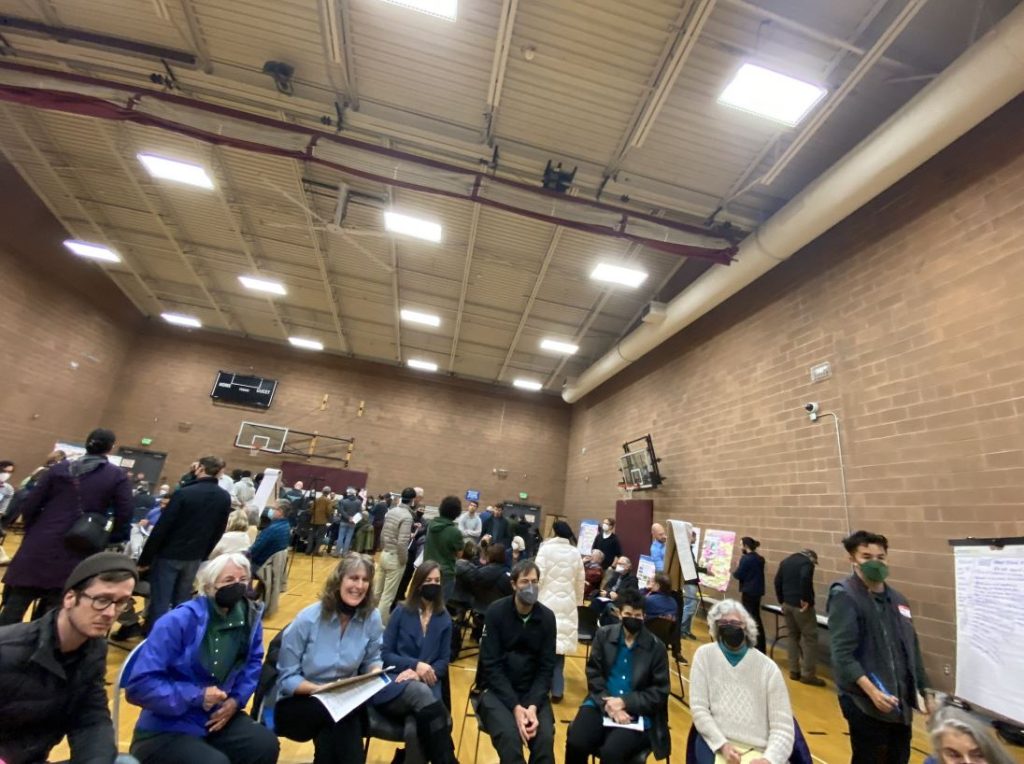
The breakout sessions allowed everyone a chance to weigh in on how Seattle should grow housing in the next comprehensive plan. When it was my turn to talk, I pointed out how they couldn’t even deliver the right number of chairs tonight, so maybe they’re also not planning for the right number of homes. Were the two people standing outside our circle supposed to go get chairs in Issaquah since we ran out in Seattle? This failure was frustrating and everyone in the circle could see the correlation, including our facilitator from Seattle’s Office of Planning and Community Development (OPCD).
After leaving the meeting, and briefly forgetting about housing, I pondered the Comprehensive Plan’s current five alternatives for housing growth and how well each would solve the chair crisis that unfolded in the gym that night. (Check out The Urbanist‘s explainer of the five alternatives for a breakdown.) It became easy to see the parallel problem we put ourselves through when we plan for the bare minimum guess. The following is an outline of the five proposed alternatives for housing being studied in the Comp Plan and how they would have dealt with the issue of needing more chairs:
Alternative 1: No Action
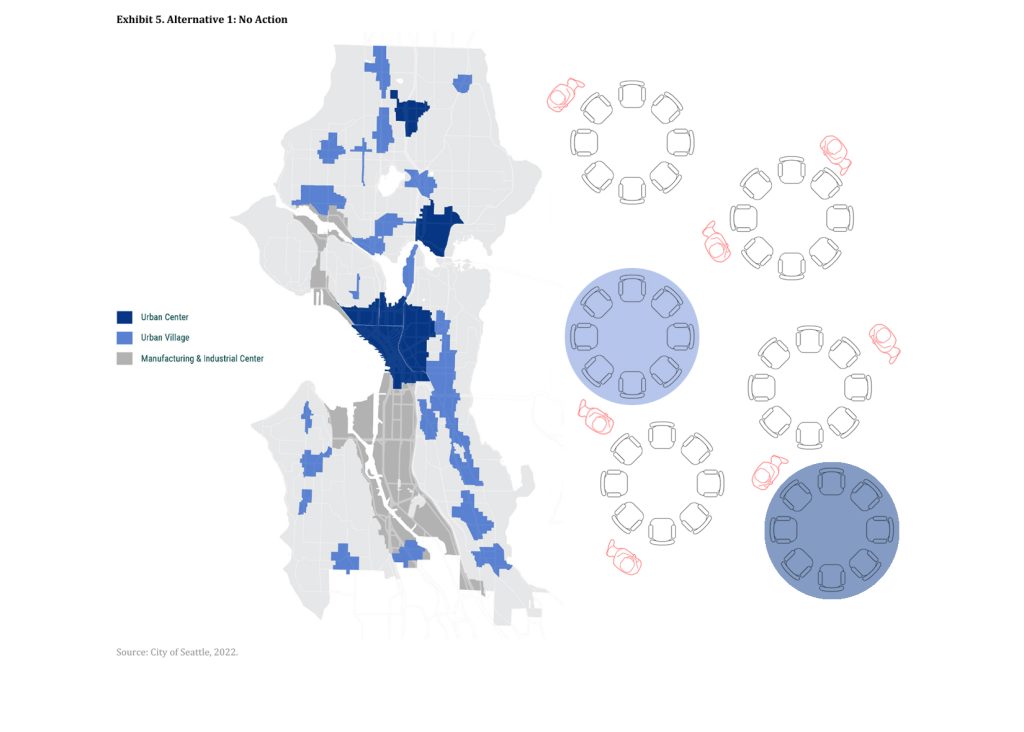
Sorry folks, I guess you are either left without a chair, or you can go to some community center 30 minutes away and hope they have some chairs. But they also have the same problems Seattle has, so chances are they’ll run out of chairs too. All Environmental Impact Statements for draft plans must include a no-action alternative as a baseline. This alternative is obviously is a disaster in waiting, but also explains the disaster we live in now as the baseline is far too low.
Alternative 2: Focused
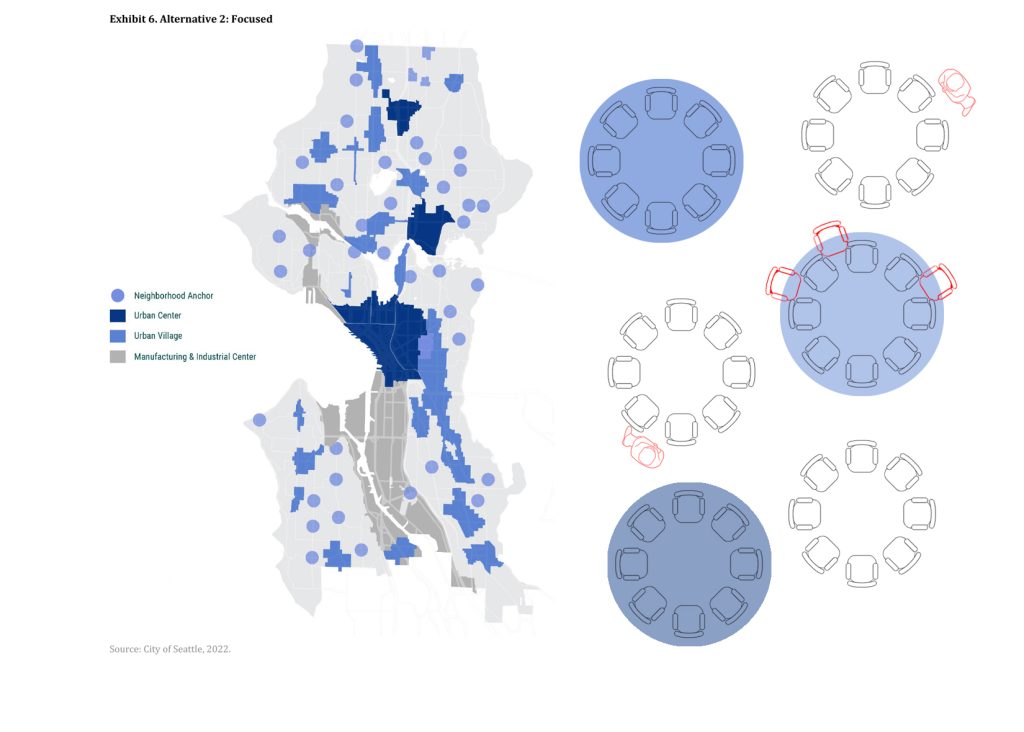
We needed many more chairs to supply everyone with a seat, and maybe enough vacant seats so people could move around and sit in the circle they like, but that’s not what this plan for focusing growth in existing clusters would have done. Even though the gym has plenty of space to add more circles, and our existing chair circles could all easily add more chairs, the Focused alternative would instead shove additional chairs into one circle and claim this is the only place to put them. We would still be many chairs short, but at least we added some, said someone that’s already seated.
Alternative 3: Broad
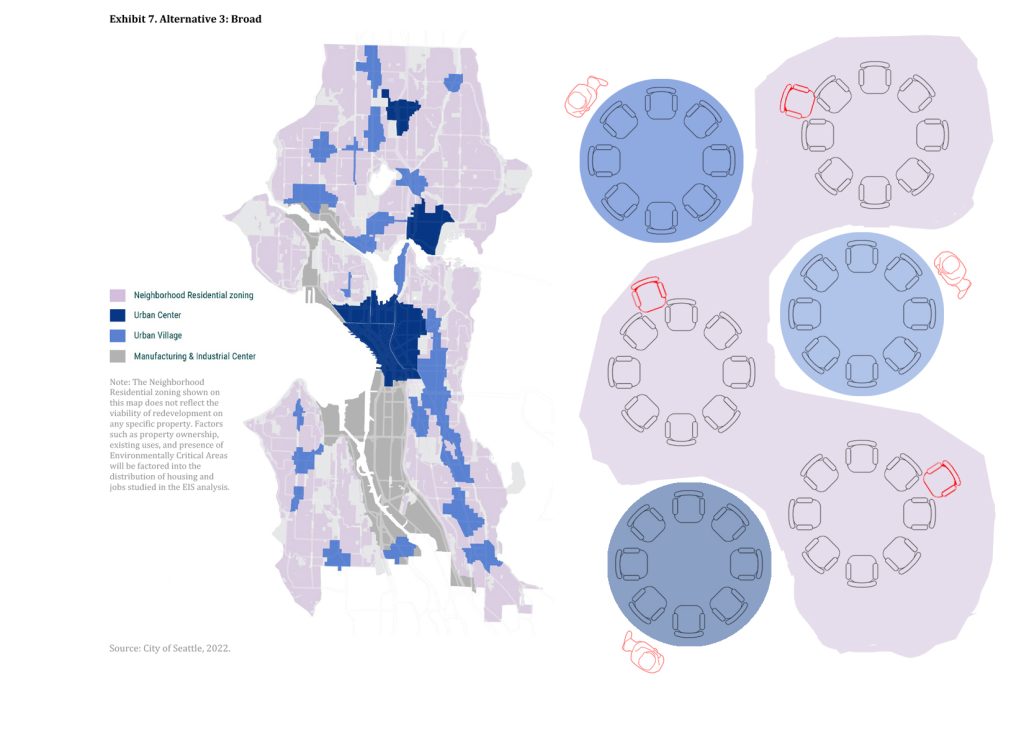
We needed many more chairs, so let’s put them in the mostly vacant parts of the gym that take up most of the room. Adding chairs there will provide comfortable seating and we can expand the services over to them in an equitable way. Like Alternative 2, we only added some chairs and are still many chairs short.
Alternative 4: Corridors
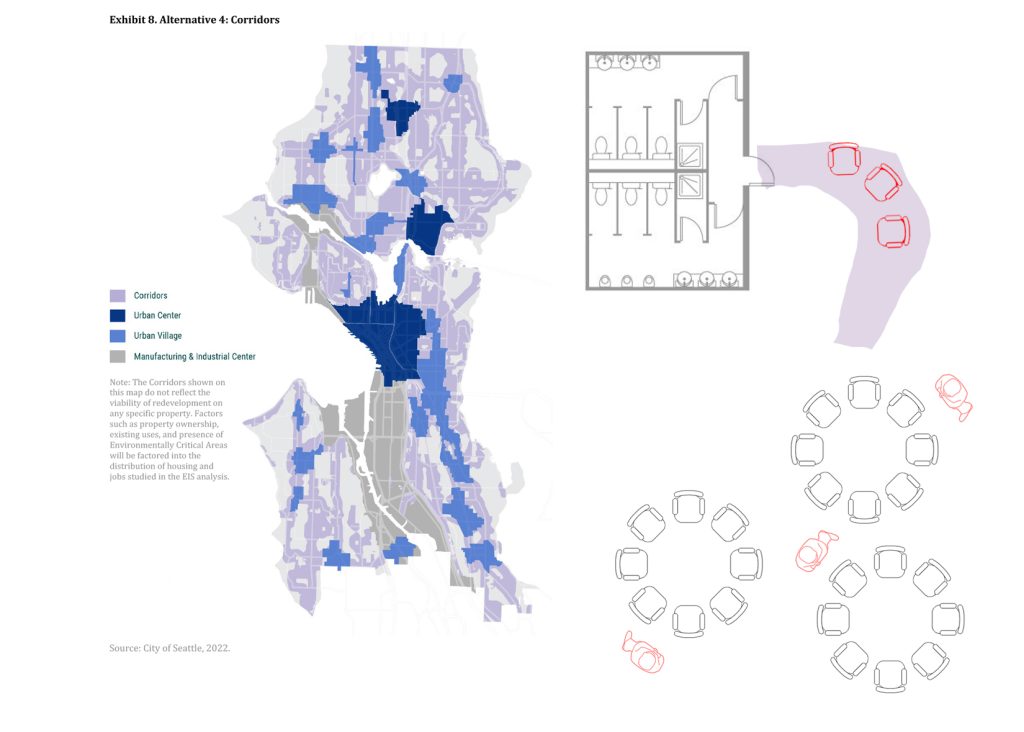
Sure, everyone needs to use the restroom, but nobody wants to sit by it. It’s loud, noisy, smelly, and you can’t wait to get as far away from it as you can after using it. But, for some reason, we will justify lining up chairs along the unpleasant path to the bathroom and design this as logical and equitable since it’s near services. Meanwhile, those comfortably spaced chair circles are once again left alone, and the bathroom seating can only accommodate a few chairs anyway, still not meeting the needed chair supply.
Alternative 5: Combined
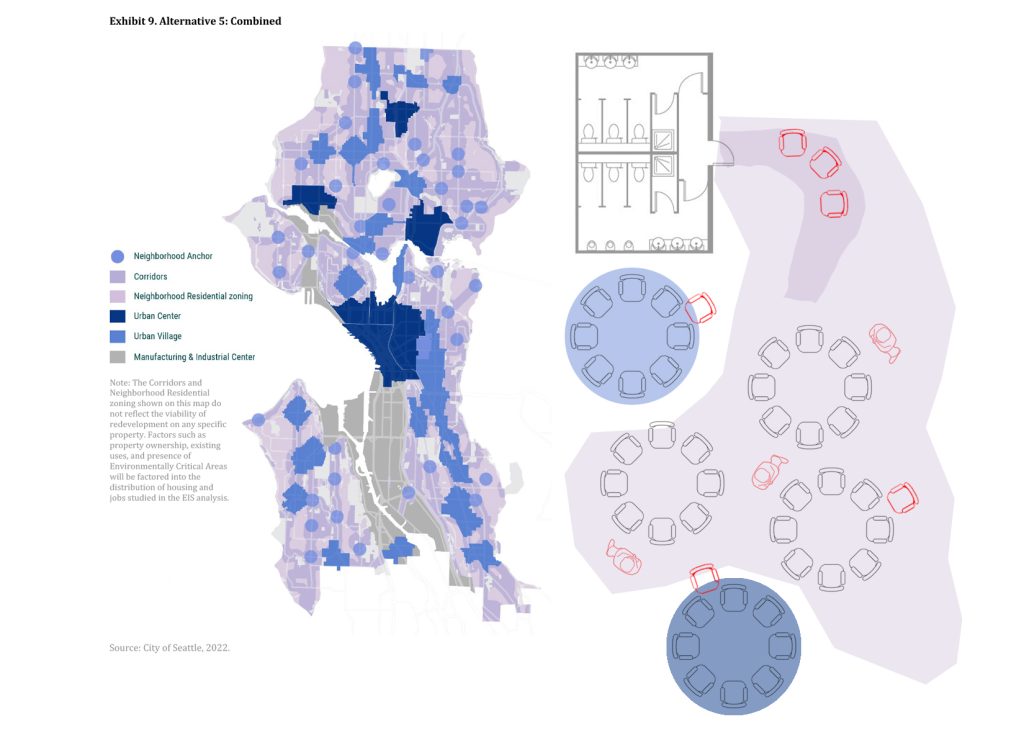
Sounds great. We can shoehorn some chairs into one circle, we can place a few chairs out in empty areas of the gym, and we can cluster more chairs next to the bathroom and say “we did it, we placed chairs everywhere” even though we still failed to supply enough chairs, and we failed to place the added chairs sustainably or equitably.
In the end, all 5 alternatives fail.
Here’s the problem with these minimal plans. While we sat around for years discussing and planning where to put those 30 chairs, more people have shown up and now we need 50, and next meeting we might be 100 chairs short. So, what do we do now when we undershot it? When all five of these plans don’t meet the needs of today or tomorrow, we need something else. Economists at BERK estimate Seattle needs 152,000 homes by 2045 or the housing crisis will worsen. Alternative 1 plans for 80,000 homes, Alternative 2, 3, and 4 only 100,000 and Alternative 5 plans for 120,000. The BERK analysis estimates if Seattle only adds 112,000 homes in that timeframe (the bare minimum to comply with the Growth Management Act), over two-thirds of the city’s homes would only be affordable to households making over 100% area median income (AMI).
So, none of these alternatives meet the mark, and 152,000 new homes only stabilizes the housing costs we have today, which are too high. The 152,000 homes should be the starting benchmark with alternatives reaching well beyond. Seattle’s most aggressive plan is 30,000 homes short of this proposed benchmark. We need a plan that surpasses minimum targets to give us breathing room so we aren’t cramped out when we do this all over again in 2032.
We need an Alternative 6
Those first five alternatives don’t come close to meeting Seattle’s needs. So let’s plan for a 6th Alternative, one that meets the mark and one that most people at the meeting I attended and that weighed in online clearly want. Councilmember Tammy Morales has even offered a great op-ed on a more robust, equitable Alternative 6, one that addresses our needs for supply and affordability.
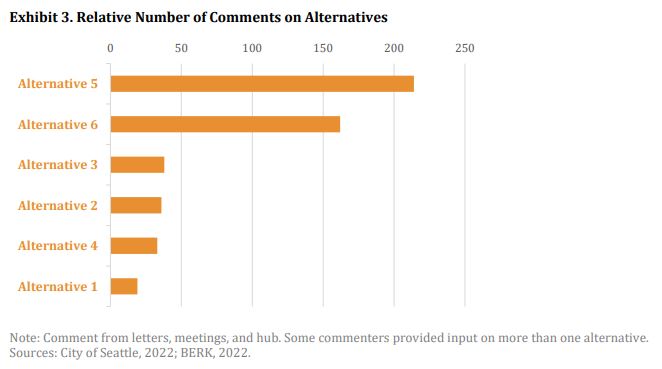
Forget about counting the exact number homes or chairs you need today. Stop trying to thread the needle before you cast the plan in stone and need to revisit it in 2032. What we need are lots of homes of varying sizes and enough capacity so we don’t leave people standing outside the circle at the next community meeting.
More than any single prescription for density or growth concept, a strong Alternative 6 will allow creativity in meeting our housing goals. Creativity means moving dense housing away from clogged arterials and not locking down huge neighborhoods in restrictive covenants or questionable historic districts. Creativity means moving away from overbuilding narrow townhomes that require a four-foot wide stair which blows out the layouts in every floor of a unit. Creativity means moving beyond duplexes and quads that are already hard to build, to allow sixplexes, polikatoikias, and point access blocks, and variations that we haven’t dreamed up yet.
While the density increase of some of these house types is encouraging — a complete buildout of sixplexes in Seattle’s single family areas would add over 800,000 additional homes — allowing varied styles reinforces the diversity and vitality of our city. The sixplex style in particular allows units large enough for families with cross ventilation and lots of daylight. They don’t need to be any taller than the neighbors. They do allow for single level homes, fully accessible interiors for those with disabilities, people aging, or people chasing little kids around. We won’t need as many more chairs if we can open all the circles to wheelchairs, couches, and stools.
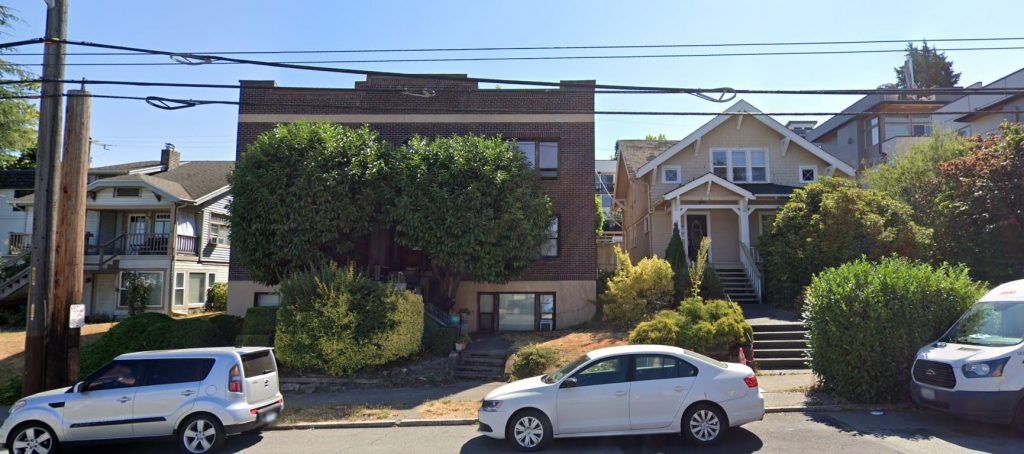
Beyond just home styles, it is vitally important to increase density many different ways and throughout the city because there is a strong likelihood that the projected numbers are too low. Just allowing sixplexes in every single family zone — along the lines of Alternative 3 — could meet BERK’s minimum projected need of 152,000 homes. But that will not be enough. The city must plan for additional capacity in the very likely case that these projections undershoot reality. And a lot of reality is coming as neighboring jurisdictions resist change or back off their own density pledges, demographics push towards urbanized areas, and climate migration gears up in haste.
A variety of upzones can give Seattle the capacity for 1 million additional homes. Imagine having 1 million chairs in the storage closet ready to deploy so we don’t have to crowd anyone out, race for empty chairs, or sit next to the bathroom. That’s what a robust, creative Alternative 6 can offer.
The city is continuing the conversation on shaping the Comprehensive Plan, with the next event on Monday, January 30th held virtually. I encourage you to attend and to push for an Alternative 6 that looks like the city you want. Tell OPCD to plan for the number homes that will actually meet our needs, plus room to spare. And since this meeting is online, it’s easier to attend, saves us all a trip to some far-flung community center with poor transit and bike access, and the planners won’t have to worry about how many chairs to bring.

Ryan DiRaimo
Ryan DiRaimo is a resident of the Aurora Licton-Springs Urban Village and board member of the neighborhood group ALUV. He works at an architecture firm downtown and seeks to leave a positive urban impact on Seattle and the surrounding metro. He advocates for more housing, safer streets, and mass transit infrastructure and hopes to see a city someday that is less reliant on the car.


